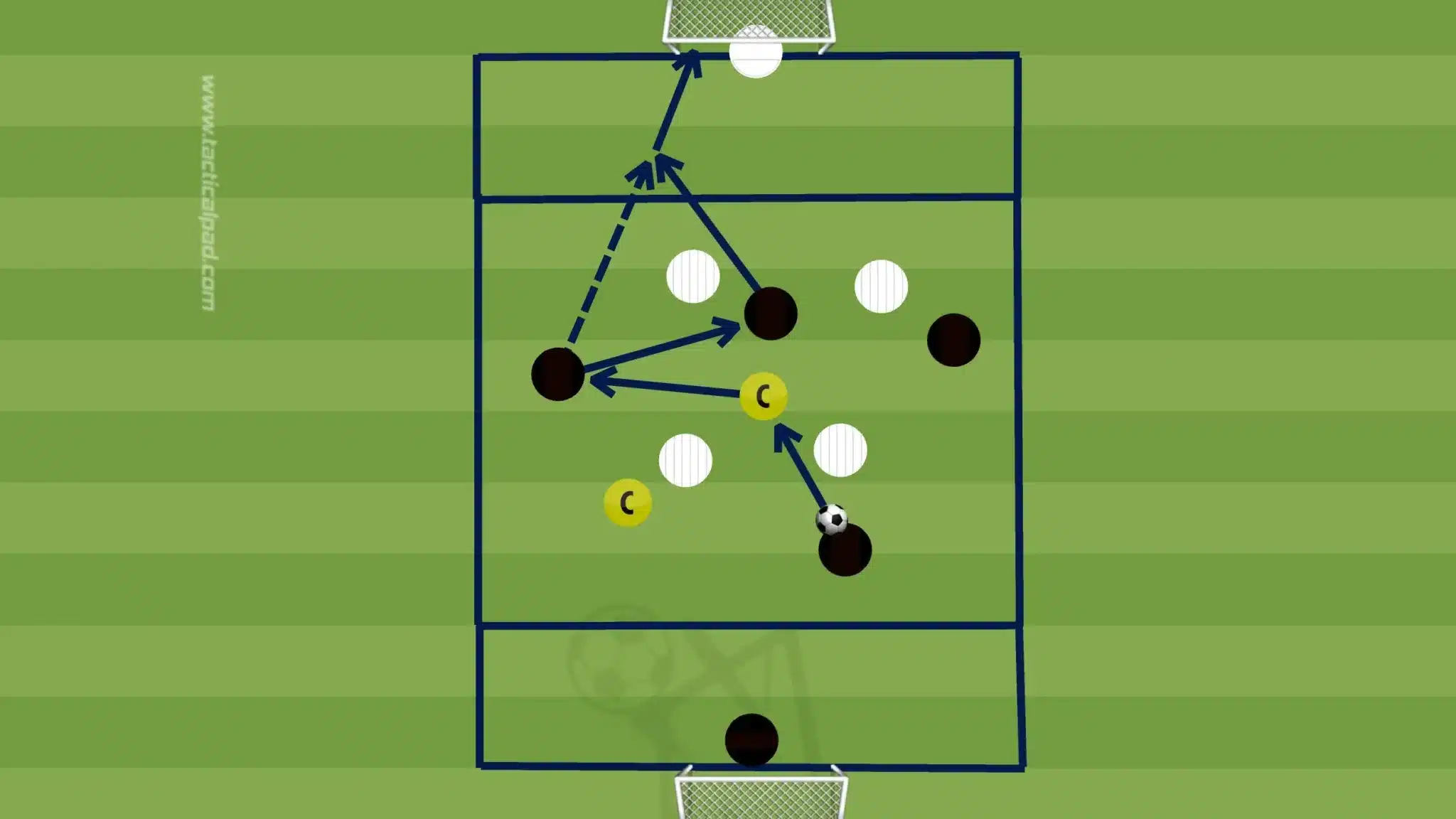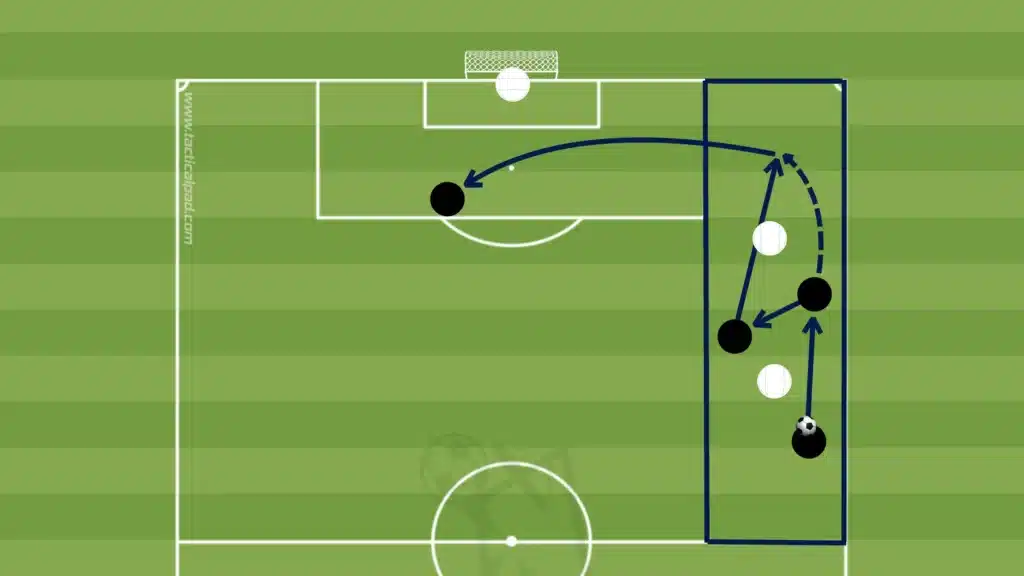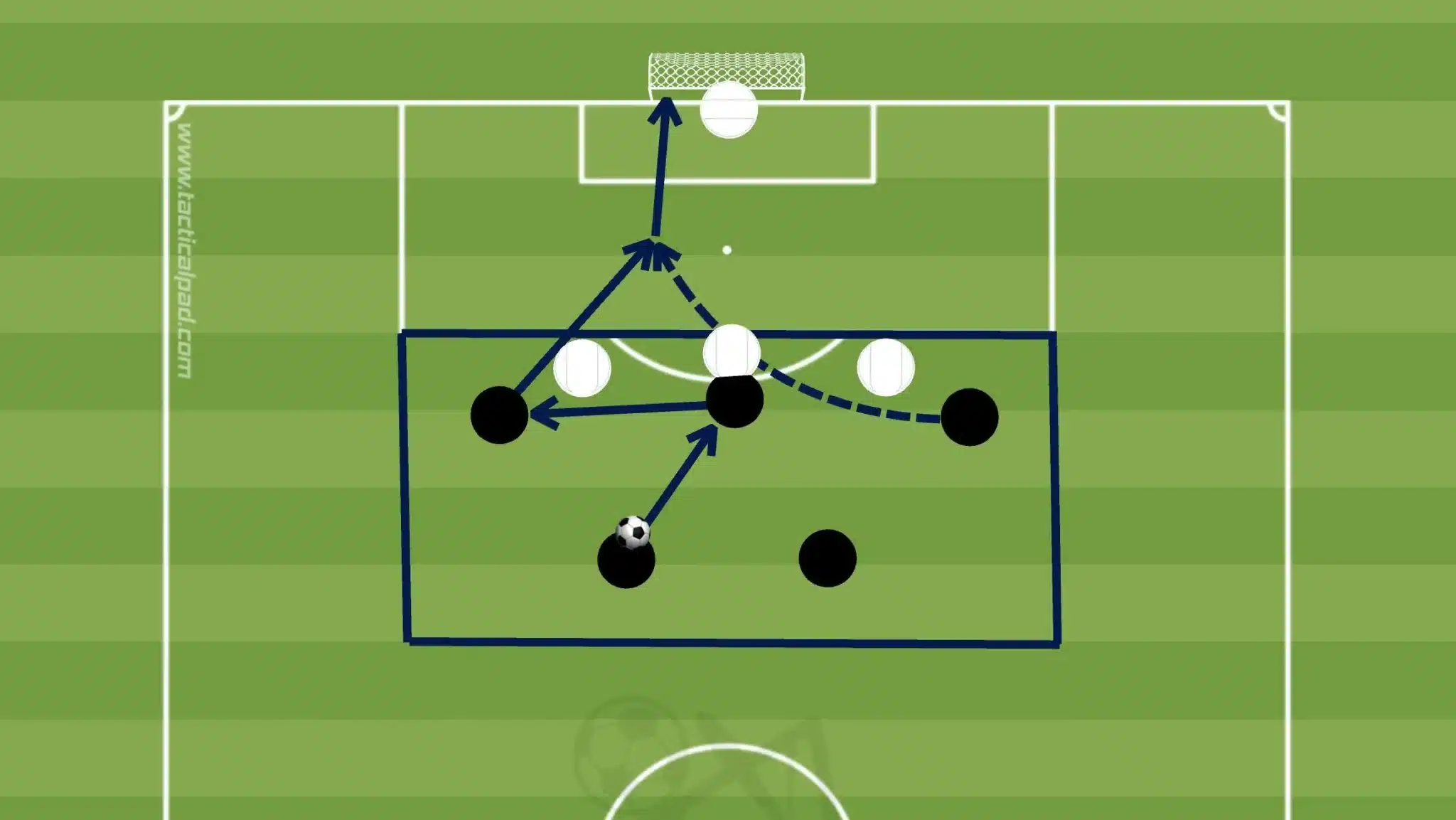Combination play is a crucial element of modern football, allowing teams to break through defensive structures by creating and exploiting overloads. By using quick passing sequences, intelligent movement, and positional rotations, teams can generate numerical advantages and break down compact defensive setups.
This article presents a set of structured drills designed to help players develop their combination play in different areas of the pitch. Each drill emphasizes quick ball circulation, off-the-ball movement, and decision-making under pressure to improve team fluidity and attacking effectiveness.
Why Combination Play Matters
Combination play is essential for teams that want to break down organized defensive blocks. The key benefits include:
- Creating numerical advantages in key areas of the pitch.
- Bypassing defensive lines through quick, well-timed passing sequences.
- Encouraging positional rotations to disorient defenders.
- Increasing attacking fluidity by improving players’ understanding of movement patterns.
To execute combination play effectively, players must develop technical skills, tactical awareness, and an instinctive understanding of space. The following drills provide a structured approach to building these attributes.
Drill 1: Breaking the Midfield Line with Combination Play
Objective:
This drill simulates breaking through an opponent’s midfield press by using quick passing combinations, third-man runs, and off-the-ball movement. It reinforces the importance of sharp decision-making when facing defensive pressure.
Setup:
- The pitch is divided into three zones: one middle zone and two attacking zones at each end.
- Teams: 4v4 in the middle zone, plus two neutral players acting as link players between the middle and attacking zones.
Instructions:
- The team in possession must move the ball through the middle zone, combining quickly to progress into the attacking zone.
- They can use the two neutral link players to help bypass the defensive press.
- The defending team applies high pressure, trying to force mistakes and win possession.
- Once the attacking team successfully breaks the midfield line, they have a few seconds to set up a shot on goal in the attacking zone.
- If the defenders win the ball, they counterattack towards their attacking zone.

Key Coaching Points:
- Players must scan before receiving the ball to identify space and pressure.
- Quick, one-touch passing helps disorganize pressing defenders.
- Third-man runs should be well-timed to exploit gaps between defensive lines.
- Players must make decisions based on defender positioning rather than predetermined patterns.
Drill 2: Triangle Combinations in Wide Areas
Objective:
This drill focuses on combination play in wide areas to create crossing or cut-back opportunities. It trains players to manipulate defensive structures through overloads.
Setup:
- A 3v2 situation on the flank, consisting of a fullback, winger, and central midfielder against two pressing defenders.
- A target player inside the box for receiving crosses or cut-backs.
- The area is marked to simulate the wide section of the pitch.
Instructions:
- The fullback starts with the ball and looks to combine with the winger and midfielder.
- Players must execute quick passing patterns, such as one-twos, overlaps, and third-man runs, to break past the defenders.
- The goal is to create space for a cross or cut-back into the penalty area.
- If defenders win possession, they clear the ball or transition into a counterattack.
- Players rotate positions after several repetitions to experience different roles.

Key Coaching Points:
- Players should use quick, short passes to move defenders and create angles.
- Timing of runs is critical—late movements are often harder to defend.
- The decision to cross or cut back should be based on defender positioning and the target player’s movement.
Drill 3: Central Overloads and Breaking the Defensive Line
Objective:
This drill helps attacking players understand how to break through compact defensive blocks using central overloads and quick passing combinations.
Setup:
- A 5v3 setup in a central zone just outside the penalty area.
- Attackers include a striker, two attacking midfielders, and two central midfielders.
- The three defenders are compact and organized, aiming to limit space.
Instructions:
- The attacking team circulates the ball, trying to manipulate the defensive line with quick one-touch passes.
- When an opening appears, attackers must use a third-man combination or a quick one-two to break into the penalty area.
- The objective is to create a clear-cut chance for a shot on goal.
- If defenders win possession, they attempt to clear or counterattack.

Key Coaching Points:
- Attackers must remain patient, waiting for the right moment to execute a decisive combination.
- The first pass should attract pressure, opening space for the third-man run.
- Off-the-ball movement should be deceptive, with feints and sudden changes of direction.
Drill 4: Positional Play in the Final Third
Objective:
This drill helps teams develop structured attacking combinations in the final third, emphasizing positional rotations and quick passing sequences to unlock defenses.
Setup:
- A 6v4 setup in the attacking third, with defenders organized in a low-block.
- Attackers include a striker, two wingers, an attacking midfielder, and two central midfielders.
- The defensive team consists of four compact defenders aiming to delay attacks.
Instructions:
- The attacking team circulates the ball, attempting to move the defensive block out of position.
- Players must create space through quick passing, decoy movements, and rotations.
- When an opening appears, the ball must be played into an onrushing attacker or midfielder for a shot.
- If defenders win possession, they counterattack into a designated transition zone.

Key Coaching Points:
- The ball must move quickly to shift defenders and open passing lanes.
- Wide players should stretch the defense, creating space for central combinations.
- Attackers must be unpredictable, using feints and disguised passes to disrupt the defensive shape.
Conclusion
Combination play is essential for breaking down compact defenses and progressing the ball efficiently. These drills help players develop the technical and tactical skills required to execute quick passing sequences, create overloads, and break through defensive lines.
Training sessions should emphasize game-realistic decision-making, encouraging players to read defensive movements rather than relying on rehearsed patterns. With a strong foundation in combination play, teams can control possession, break down stubborn defenses, and create more goal-scoring opportunities.
